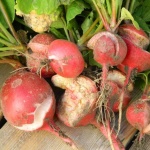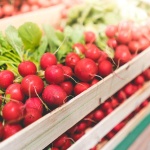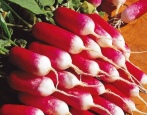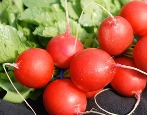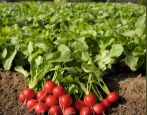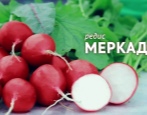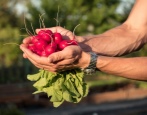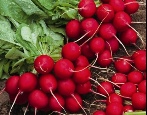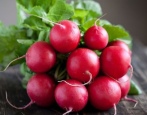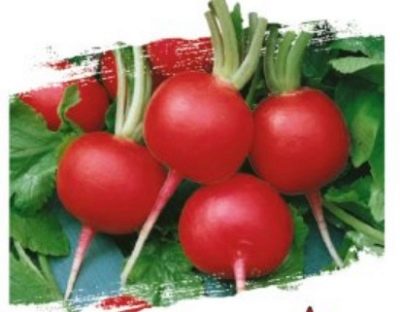
- Authors: Vinogradov Z.S., Saprykin A.E.
- Year of approval: 2007
- Ripening terms: mid-season
- Leaf rosette shape: semi-upright
- Leaves: obovate, yellowish green
- Petiole: with anthocyanin coloration
- The form: rounded
- Coloration: Red
- Weight, g: 23-25
- Color of the pulp: white
Radish, earlier than other plants, pleases domestic gardeners with a harvest. It is sown early, and it ripens quite quickly, which is why it is in such demand, despite its taste specificity. The Duro Krasnodarskoe variety is one of the most popular in our country due to its excellent taste and unpretentious cultivation.
Description of the variety
Duro Krasnodarskoe belongs to varieties with high yields, universal in purpose. It can be grown throughout the year in a greenhouse without interruption. It also performs well outdoors in tunnels under agrofibre. There are a number of advantages that make it very popular:
large fruits that do not crack from lack of moisture;
no color;
stored in the refrigerator for about a month;
not particularly picky about the soil composition;
able to mature several times per season;
planted in spring and autumn;
high level of productivity;
good taste, tenderness of the pulp;
rises evenly, ripens heap.
In open ground, this variety is planted from April to October in different ways: in wide rows, one-line method. As for the shortcomings of the variety, significant ones have not yet been identified.
Characteristics of the appearance of the plant and root crops
The visual characteristics of the fruit are as follows:
round shape of a ball;
flat head;
diameter about 8-10 cm;
the color is red, the tip is whitish;
the skin is smooth, even;
weight varies from 23 grams;
the flesh is white.
The plant itself stretches up to 25 cm, has an erect rosette, with an anthocyanin petiole.
Purpose and taste of tubers
Radish of this variety contains many useful trace elements and vitamins, so it is recommended for a healthy diet. Duro is devoid of the common bitter taste, so it can be more actively used in cooking. The taste of this radish is very soft, sweetish without specific harshness, but with a sharp edge. It is suitable for fresh consumption and after heat treatment. The pulp is white, crunches, rather dense, but tender, juicy. Ideal for salads with vegetables, okroshka, served with meat dishes. And you can also use Duro tops, it is suitable for soups - both cold and hot. Stores well, remains elastic for a long time.
Maturation
You can sow this type of radish several times per season, even all year round, so the timing of the event is quite variable. It ripens quite quickly, after about 25 days it will be possible to harvest the first crop. The maximum ripening period is 1 month. It should be noted that the duration may vary up or down, taking into account the climatic characteristics of the region and the weather in the season.
Yield
Gardeners appreciate this type of radish for its good yield indicators. Usually, an average of 2.6 to 3.4 kg is collected from a square meter. The amount depends on the terrain, soil, care literacy. Radishes are stored for about a month in the refrigerator.
Growing and care
This variety feels best at a temperature of 16 to 20 degrees, but fluctuations in the direction of increase do not negatively affect productivity, provided a competent approach to agricultural technology. To begin with, choose the right site for planting, if tomatoes, cabbage, legumes, strawberries grow nearby, this is very good for this variety. But you should not plant Duro next to onions, cucumbers, and also do not choose the soil where crucifers used to grow.
The ideal soil for this variety is loose, but if you are ready for frequent weeding, the type of soil does not really matter. Duro radishes grow best in well-lit areas, or in a warm place, for example, in a greenhouse. Growing should include a number of mandatory activities.
Watering. It is carried out regularly, as needed, when the earth dries up. You cannot overdo it with moisture, otherwise the root crop will begin to rot. For a square meter of planting, 10 liters of water or a little more is enough.
Weeding. Another important part of the care is done after moisturizing. Weeds must be removed carefully so as not to damage the roots of the young radish.
Fertilizer. This variety is fed during growth with complex nitrogenous compounds. Superphosphate, saltpeter, ash are well suited. Eliminate manure, as it negatively affects the taste of Duro.
If you have planted a dense radish, it must be thinned so that there is at least 5 cm of space between the shoots. Ripe fruits are harvested immediately, it is impossible to compose them in the soil, as this worsens the taste of the radish, the peel does not take on a very aesthetic appearance.
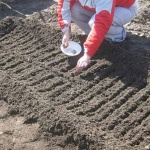


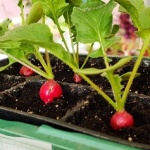
Disease and pest resistance
Since this variety is famous for its good immunity, many diseases are not afraid of it. But if the cultivation is inadequate, the care is inadequate, the risk of disease is quite high. Most problems can be resolved by spotting the signs in time.
Damping out, bacteriosis. Moderate watering, steaming the soil and treating the seeds before sowing can be considered preventive.
Powdery mildew. It is important to observe crop rotation, process seeds and isolate from plants that often suffer from this ailment.
Keela. To get rid of outgrowths and sluggish leaves, you need to water the plant with a lime solution.
Blackness of roots. Gray-blue spots on the fruits are an excuse to remove all diseased plants and disinfect the soil. Watering is reduced.
White rust. It is important to carry out the treatment with fungicidal compositions on time.
